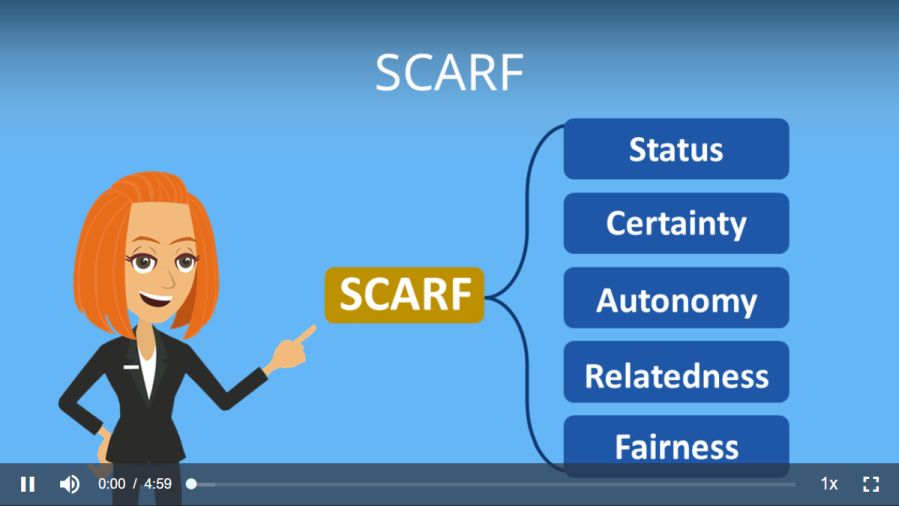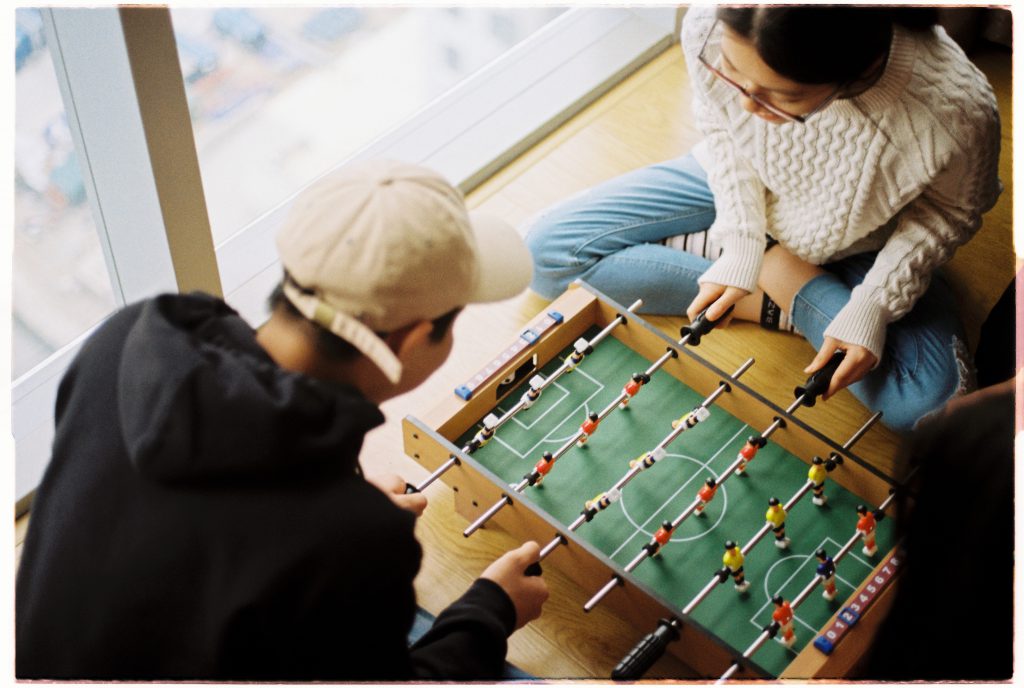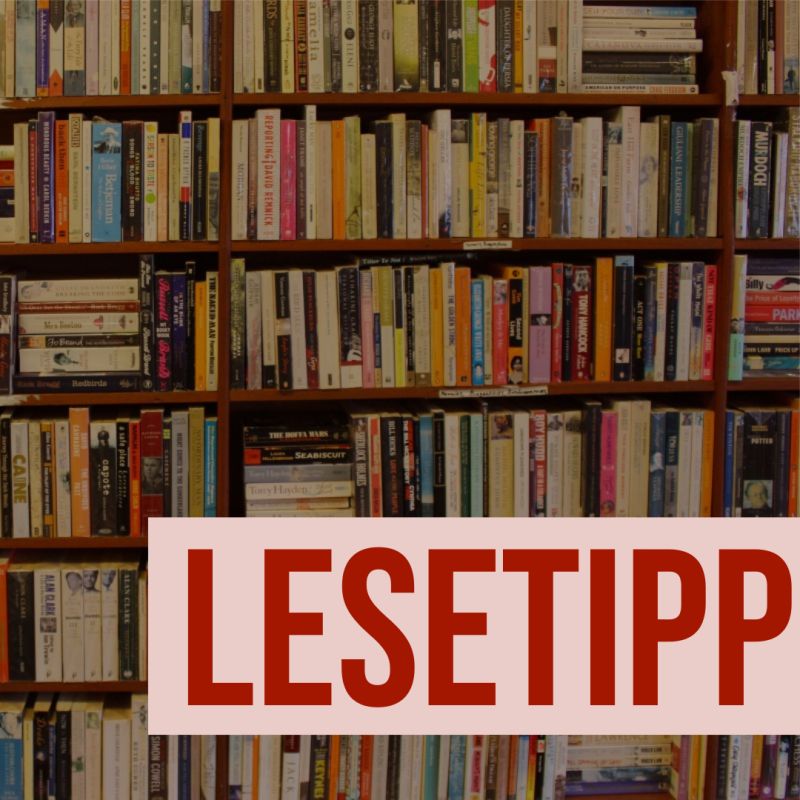
As a trainer, how can I create a safe framework for collaborative learning?
Haven’t we done that already? Why another #dimi on this topic? The answer is that creating a collaborative learning environment is one of the most central questions in the design of learning processes and therefore deserves a lot of attention.
This blog post addresses the question of what makes a group work well and what it takes for me as a trainer to make this happen.
Using the SCARF model, I will explain why group work and other forms of collaborative learning can unconsciously generate a lot of stress and what we as trainers can do to turn stress into a positive learning zone.
In order to follow well on from the #dimi_17, I will summarise the most important statements once again:
- Collaborative learning facilitates the processing of knowledge: Learning does not work without intensive engagement with the course content and interaction among learners. Discussing, researching and finding solutions together is a core element of a successful learning process.
- Collaborative learning needs a safe framework: Creating this safe framework is a central task of trainers. The fact that this often remains underexposed may have to do with our own fears as trainers. Facilitating group processes is a task that requires a lot of social sensitivity and for which trainers are often ill prepared.
- Collaborative learning supports the acquisition of competences: The trade union’s educational goals are oriented towards a variety of competences – if we take these educational goals seriously, we cannot avoid thinking about how these can be developed. Collaborative learning makes an important contribution to this. This learning is transversal to the learning content and needs not only the attention of the trainers but also a clear framework that is supported and maintained by the course management.
While #dimi 17 was mainly about creating a basic understanding of collaborative learning, this blog post will focus on the role of facilitation by trainers. A helpful model I would like to refer to is the SCARF model according to David Rock.

The model describes how social interaction affects learning and provides interesting clues for guiding learning processes in which trainers place learners at the centre. It provides valuable information on how stress reactions, which often arise in small groups where learners work independently on their learning tasks, can be steered in a productive direction. In terms of the learning process, the question is what makes learners engage in group learning and use it for competence building.
SCARF stands for…
- S: Status
- C: Certainty
- A: Autonomy
- R: Relatedness
- F: Fairness
Let’s take a closer look at the individual aspects of the SCARF model and how they emerge in the cooperation among learners. I will try to describe possible thoughts of learners and deduct ideas for guidance from them.
S for Status
In the first step of the group or project work, the working group is formed in which each individual is initially concerned with his/her own positioning within this group.
Questions that the learners usually ask themselves silently are:
- Who is taking the lead here? Does this suit me or not?
- Do I want to support this person or does this behaviour annoy me?
- How do I relate to the rest of the group? How do the others see me?
- Am I perceived as competent? Who do I perceive as competent?
- Do I have any influence on the others?
- Are my suggestions and ideas taken up and are there people who confirm and support them?
- Arethere others who might question my competence?
Reflection for learning support: If I notice that there are entrenched roles in a group (e.g. dominant persons, striving persons…) I can consider whether and how I would like to break up the roles, e.g. by sharing this observation and encouraging people to reflect on these patterns and possibly consciously define new roles as a learning field and try them out. As a trainer, I then encourage reflection on this, which ideally leads to an expansion of competences.
C for Certainty
The aspect of certainty can be described as the individual’s need for a „safe place to learn“. The members of a small group interact in an intense way with each other in the course of group work. There can be subtle exclusion and inclusion scenarios that I as a trainer may not even notice. Even the phase of finding a group can be stressful and uncomfortable for learners. Similar to the situation of „choosing“ for team sports in school gym classes, there is also choosing during the group finding phase. Learners are asked the question, „Can I be part of what I would like to be part of?“ At the core of this is the question of social recognition and the question of safety in the group. Safety also comes from experiencing that transgressions or violations of group rules are addressed.
Reflection for learning guidance: The concept of understanding care (Joachim Bauer) describes the role of learning guide as „a balance between understanding care and guidance“. Understanding care refers to the recognition of the learner as a whole person, i.e. with different personality traits and competences. Under the aspect of leadership, this means the importance of representing clear values and standing up for them. In the sense of a safe framework, this also means that problematic behaviours that become visible in the cooperation (subtle or obvious exposures or insults, exclusion) are not ignored by the learning facilitator or that a safe framework is created for discussion.
A Autonomy
The experience of autonomy is a prerequisite for motivation for many learners. Learners who feel restricted for various reasons often resist. This often becomes apparent right at the beginning of group work, for example, when the task is questioned or „creatively modified“. Needs that become effective here are: Do I have the right to move „freely“ as an individual, to make decisions myself, to shape things myself and to prove my individuality?
Reflection for the learning guide: As a learning guide I am moving in the field of tension between framework and freedom. What creates the necessary clarity and where can the learners experience themselves as self-effective? From my point of view, it makes sense to clearly define the work assignment (WHAT) and to give the learners room for manoeuvre in the implementation (HOW) or even to consciously invite them to shape it freely. The message to the learners would then be: „Think for yourself how you can best achieve the agreed learning goal and then explain to me why you have chosen this path.“
R Relatedness
In collaborative learning situations, our basic human need for relatedness becomes apparent. If a group manages to work together constructively, it increases motivation and willingness to learn. If it does not succeed, the cooperation usually suffers seriously. The learners‘ experience here revolves around all the aspects that have already been described, but also around the area of fairness. I would also like to refer again to the distinction between cooperation and collaboration that I described in #dimi_17. The outcome of a collaborative learning process is one that can only emerge from the fruitful interaction of the group.
Reflection for learning guidance: Here, too, the motto for me is: less WHAT and more HOW! This means that it is not only the learning outcomes of a group that count, but also how they have achieved them. As a facilitator, I can influence this framework by encouraging learners to observe and describe their learning process, for example, by asking reflection questions or scheduling facilitated reflection sessions, thus supporting and guiding the group.
F Fairness
The perception of fairness is enormously effective in the context of collaborative learning. Many conflicts, especially when it comes to larger group or project work, revolve around this aspect: Who takes on how much of a task? Who delivers the results at agreed times? Who ensures that these are put into a presentable form? The well-known phenomena of group work, such as the „freerider effect„, come into their own here. Experience shows that the group often splits up over the demand for perfection. A large part of the work is left to those who have high standards and are ashamed of the group’s mediocre results and then invest even more hours on their own to „improve“ the group’s results.
Reflection for the learning guide: As a learning guide, it makes sense from my point of view to greatly reduce the demands on the presentation of learning outcomes (final content presentation, joint final paper) and to be clear about which learning goals the learners should achieve. It makes sense to encourage learners to take a closer look at the learning process and to describe what questions they asked themselves, how they found responses and what results they arrived at. It can also bring awareness to different types of contributions and encourage the group to negotiate a fair distribution from the beginning and to disclose responsibilities.
Collaboration is more than the sum of individual contributions
In order to make this kind of learning possible, the facilitation of the learning process takes on a central role, which trainers should consciously design and structure. The content-related learning goals are expanded by a holistic view of the targeted competences
Developing a genuine and sustainable feedback culture is a fixed point of every collaborative learning process. These skills do not develop out of the blue, but need to be systematically integrated into the learning arrangements. The trainer’s task is to stimulate discussion with the help of thoughtful questions, but also to act as a role model by addressing critical points and encouraging the finding of solutions.
For me, this part of the work is sometimes the most interesting, because it results in enormously exciting questions that provide a lot of food for thought and discussion. What do you think?
Would you like to browse further?
- Meister, Norbert; Ofner-Reßler, Lukas (2022): Give me a little bit of security. How much stability does change need? In: Early roots of modern experiential education, experience & learn. International Journal for Action-Oriented Learning 30 (1). Augsburg: ZIEL GmbH, pp. 27-30.
- Learning in groups: Phenomena in group work (scroll down)
- The role of the facilitator
- A good overview of cooperative learning
- Do we learn better together with others?
- 10 Recommendations for Improving Group Work
These (and other) books can be ordered free of charge from the Austrian Trade Union Federation’s webshop HERE.
Author: Margret Steixner
Translation: Astrid Donaubauer

Dieses Werk ist lizenziert unter einer Creative Commons Namensnennung-NichtKommerziell-Weitergabe unter gleichen Bedingungen unter gleichen Bedingungen 3.0 Österreich Lizenz.
Volltext der Lizenz







